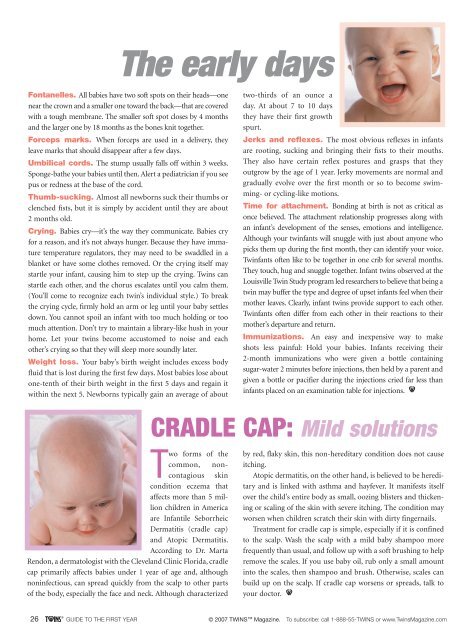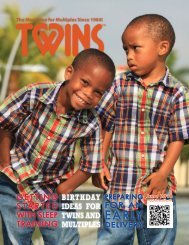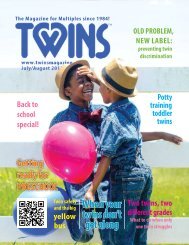2007GuideToTheFirstYear
You also want an ePaper? Increase the reach of your titles
YUMPU automatically turns print PDFs into web optimized ePapers that Google loves.
The early days<br />
Fontanelles. All babies have two soft spots on their heads—one<br />
near the crown and a smaller one toward the back—that are covered<br />
with a tough membrane. The smaller soft spot closes by 4 months<br />
and the larger one by 18 months as the bones knit together.<br />
Forceps marks. When forceps are used in a delivery, they<br />
leave marks that should disappear after a few days.<br />
Umbilical cords. The stump usually falls off within 3 weeks.<br />
Sponge-bathe your babies until then. Alert a pediatrician if you see<br />
pus or redness at the base of the cord.<br />
Thumb-sucking. Almost all newborns suck their thumbs or<br />
clenched fists, but it is simply by accident until they are about<br />
2 months old.<br />
Crying. Babies cry—it’s the way they communicate. Babies cry<br />
for a reason, and it’s not always hunger. Because they have immature<br />
temperature regulators, they may need to be swaddled in a<br />
blanket or have some clothes removed. Or the crying itself may<br />
startle your infant, causing him to step up the crying. Twins can<br />
startle each other, and the chorus escalates until you calm them.<br />
(You’ll come to recognize each twin’s individual style.) To break<br />
the crying cycle, firmly hold an arm or leg until your baby settles<br />
down. You cannot spoil an infant with too much holding or too<br />
much attention. Don’t try to maintain a library-like hush in your<br />
home. Let your twins become accustomed to noise and each<br />
other’s crying so that they will sleep more soundly later.<br />
Weight loss. Your baby’s birth weight includes excess body<br />
fluid that is lost during the first few days. Most babies lose about<br />
one-tenth of their birth weight in the first 5 days and regain it<br />
within the next 5. Newborns typically gain an average of about<br />
two-thirds of an ounce a<br />
day. At about 7 to 10 days<br />
they have their first growth<br />
spurt.<br />
Jerks and reflexes. The most obvious reflexes in infants<br />
are rooting, sucking and bringing their fists to their mouths.<br />
They also have certain reflex postures and grasps that they<br />
outgrow by the age of 1 year. Jerky movements are normal and<br />
gradually evolve over the first month or so to become swimming-<br />
or cycling-like motions.<br />
Time for attachment. Bonding at birth is not as critical as<br />
once believed. The attachment relationship progresses along with<br />
an infant’s development of the senses, emotions and intelligence.<br />
Although your twinfants will snuggle with just about anyone who<br />
picks them up during the first month, they can identify your voice.<br />
Twinfants often like to be together in one crib for several months.<br />
They touch, hug and snuggle together. Infant twins observed at the<br />
Louisville Twin Study program led researchers to believe that being a<br />
twin may buffer the type and degree of upset infants feel when their<br />
mother leaves. Clearly, infant twins provide support to each other.<br />
Twinfants often differ from each other in their reactions to their<br />
mother’s departure and return.<br />
Immunizations. An easy and inexpensive way to make<br />
shots less painful: Hold your babies. Infants receiving their<br />
2-month immunizations who were given a bottle containing<br />
sugar-water 2 minutes before injections, then held by a parent and<br />
given a bottle or pacifier during the injections cried far less than<br />
infants placed on an examination table for injections.<br />
Two forms of the<br />
common, noncontagious<br />
skin<br />
condition eczema that<br />
affects more than 5 million<br />
children in America<br />
are Infantile Seborrheic<br />
Dermatitis (cradle cap)<br />
and Atopic Dermatitis.<br />
According to Dr. Marta<br />
Rendon, a dermatologist with the Cleveland Clinic Florida, cradle<br />
cap primarily affects babies under 1 year of age and, although<br />
noninfectious, can spread quickly from the scalp to other parts<br />
of the body, especially the face and neck. Although characterized<br />
CRADLE CAP: Mild solutions<br />
by red, flaky skin, this non-hereditary condition does not cause<br />
itching.<br />
Atopic dermatitis, on the other hand, is believed to be hereditary<br />
and is linked with asthma and hayfever. It manifests itself<br />
over the child’s entire body as small, oozing blisters and thickening<br />
or scaling of the skin with severe itching. The condition may<br />
worsen when children scratch their skin with dirty fingernails.<br />
Treatment for cradle cap is simple, especially if it is confined<br />
to the scalp. Wash the scalp with a mild baby shampoo more<br />
frequently than usual, and follow up with a soft brushing to help<br />
remove the scales. If you use baby oil, rub only a small amount<br />
into the scales, then shampoo and brush. Otherwise, scales can<br />
build up on the scalp. If cradle cap worsens or spreads, talk to<br />
your doctor.<br />
26 GUIDE TO THE FIRST YEAR © 2007 TWINS Magazine. To subscribe: call 1-888-55-TWINS or www.TwinsMagazine.com


















